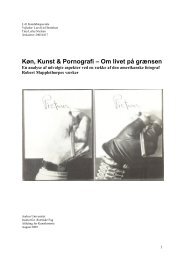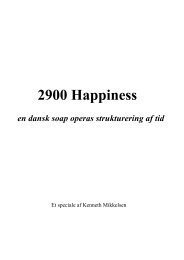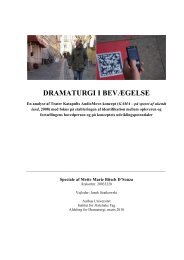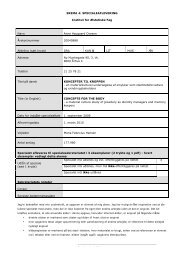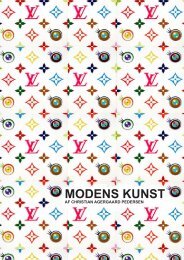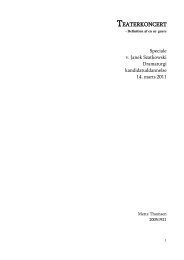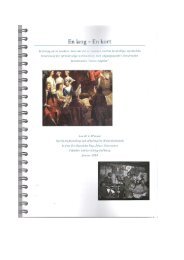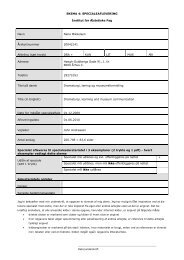Afdeling for Æstetik og Kultur — Tværæstetiske Studier - AU Library ...
Afdeling for Æstetik og Kultur — Tværæstetiske Studier - AU Library ...
Afdeling for Æstetik og Kultur — Tværæstetiske Studier - AU Library ...
Create successful ePaper yourself
Turn your PDF publications into a flip-book with our unique Google optimized e-Paper software.
Speciale af Helle Børsen Rosholm Vejleder Hans Jørgen Frederiksen<br />
Årskortnummer 20032411<br />
English summary<br />
In the last three decades of the 19. century, various ideas from psychol<strong>og</strong>y, philosophy and<br />
religious trends merged with other currents to feed broad-based dissatisfaction, with the values<br />
inherent in biol<strong>og</strong>ical and evolutionary ideas of human achivement, and specifically with the<br />
dominant ideals of elaborate mimesis in art. A key to pr<strong>og</strong>ress in the artistic field of thought<br />
in<br />
the 1880s and 1890s was a revival of an Enlightment view of the mind, separate from<br />
biol<strong>og</strong>ical and historical considerations. This was the intellectual environment <strong>for</strong> Gauguins<br />
carreer as an artist. In creating new works of art, Gauguin drew from countless sources of<br />
inspiration in an eclectic and subjective manner. He combined his impressions and ideas<br />
with<br />
his fellow artist’s imageries and notions into astonishing painted collages. The metaphorical,<br />
expanded use of the term ”collage” developed by arthistorian Camilla Paldam is inspired<br />
by a<br />
pragmatic<br />
notion of the collage in which the collage is defined by structure rather than<br />
technique: elements that are in the wrong place, in the wrong context in surprising<br />
constellations. The collage consists of juxtaposed elements, elements that we as viewers<br />
combine into a unit. This mode of borrowing sources used <strong>for</strong> the first time in ”Nude study<br />
(Woman Sewing)” was to serve Gauguin throughout his life, and when Gauguin paid homage<br />
to the provincial art of Brittany, he took the most general stylistic encouragement from its<br />
rustic naiveté; and he mixed these admirations with a seemingly capricious attention to<br />
Oriental, South American, and early Western arts into an eclectic, ambigous and surprising<br />
unity.<br />
One of the philosphical trends that inspired Gauguin and his circle was the<br />
Neoplatonic way of thinking that offered a metaphysical security, an antidote to and escape<br />
from the relativity of everyday world. This philosophy made an attractive alternative to the<br />
widespread dissatisfaction with positivism. In this notion, the use of memory would help<br />
simplify the image, in fact necessitated the paring down to essentials and the exaggeration of<br />
certain aspects. Memory also had an epistemol<strong>og</strong>ical and ontol<strong>og</strong>ical prioriry given to it by the<br />
Neoplatonic tradition wherein the soul had the ability to rec<strong>og</strong>nize Truth because it had<br />
prenatal aquaintance with the Forms or Ideas. The turn inwards to paint from memory offered<br />
Gauguin a way of using all his sources of inspiration freely and eclectic.<br />
89





